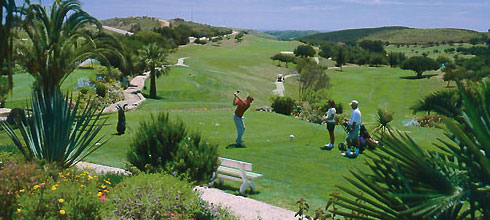Bunkers:
To begin with the sand bunkers, which are the most prevalent golf course pitfall that are included on golf courses. Sand bunkers are included on almost every hole of the course, and can come in various sizes and depth. There are really two types of bunkers, those of the green-side bunkers and fairway bunkers. The difference lies in their relative position on the golf hole, with the green-side bunkers located around the greens, and fairway bunkers which are located along the fairway. These bunkers are strategically placed by course designers, and while smaller shallower bunkers are a relatively minor pitfall, deep bunkers can be harder to escape from smoothly. Even if you do not land in a bunker, it may be that a bunker can prevent a chip to the green and require an alternative approach. For sand bunkers, there are sand wedges which are clubs specifically designed to assist with escaping the bunkers.
Water:
The water pitfall is one that is included with lakes, ponds, and creeks included on the golf course. These are not included on every golf course, however on those that do have water and lakes can be one of the biggest golf course pitfalls. This is because if a ball lands in a lake or creek then it is more than likely that it will be gone, and you will likely have to drop ball and add a stroke to the score-card. If a ball lands in very shallow water then it may be possible to avoid the penalty, but this is less than likely. As such, water and lakes is something to aim well clear off, even if that means a shorter distance shot.
 Trees:
Trees:Trees can come in various shapes and sizes, and all golf courses will surely have trees on a few holes. Most will surround the golf hole, meaning that any shot that strays some way left or right of the fairway could end up landing close to the trees. In such an event, if a ball lands very close to a tree trunk then this could prevent a standard swing, and in the worst cases make the ball unplayable. As such, the trees are very much something that golfers need to take into account.
Bushes:
Like trees, most golf courses will have at least a few bushes surrounding the holes. Golf holes that have many surrounding bushes can be higher scoring holes with balls lost in the bushes. If a ball lands in a bush, then almost certainly it will be unplayable, even if found. Even if a ball lands close to a bush, then this could still have an impact on the swing. So bushes are in some ways comparable to water pitfalls, in that you can expect that if your balls land in them they will be lost and result in a penalty stroke.
Rough grass:
Rough grass is really longer grass than surrounds the fairway or green. Overall, the rough can be short rough, or longer rough. Overall, in most cases if a ball lands in the rough then it will likely still be playable. However, it may require a number of potential adjustments in terms of club selection and swing
Overall, these are the most standard golf course pitfalls that will be included on the golf course. Bunkers, the rough, lakes and creeks, bushes, and trees are all potential pitfalls on golf courses and holes. Such golf course pitfalls could all potentially inflate golf scoring.









